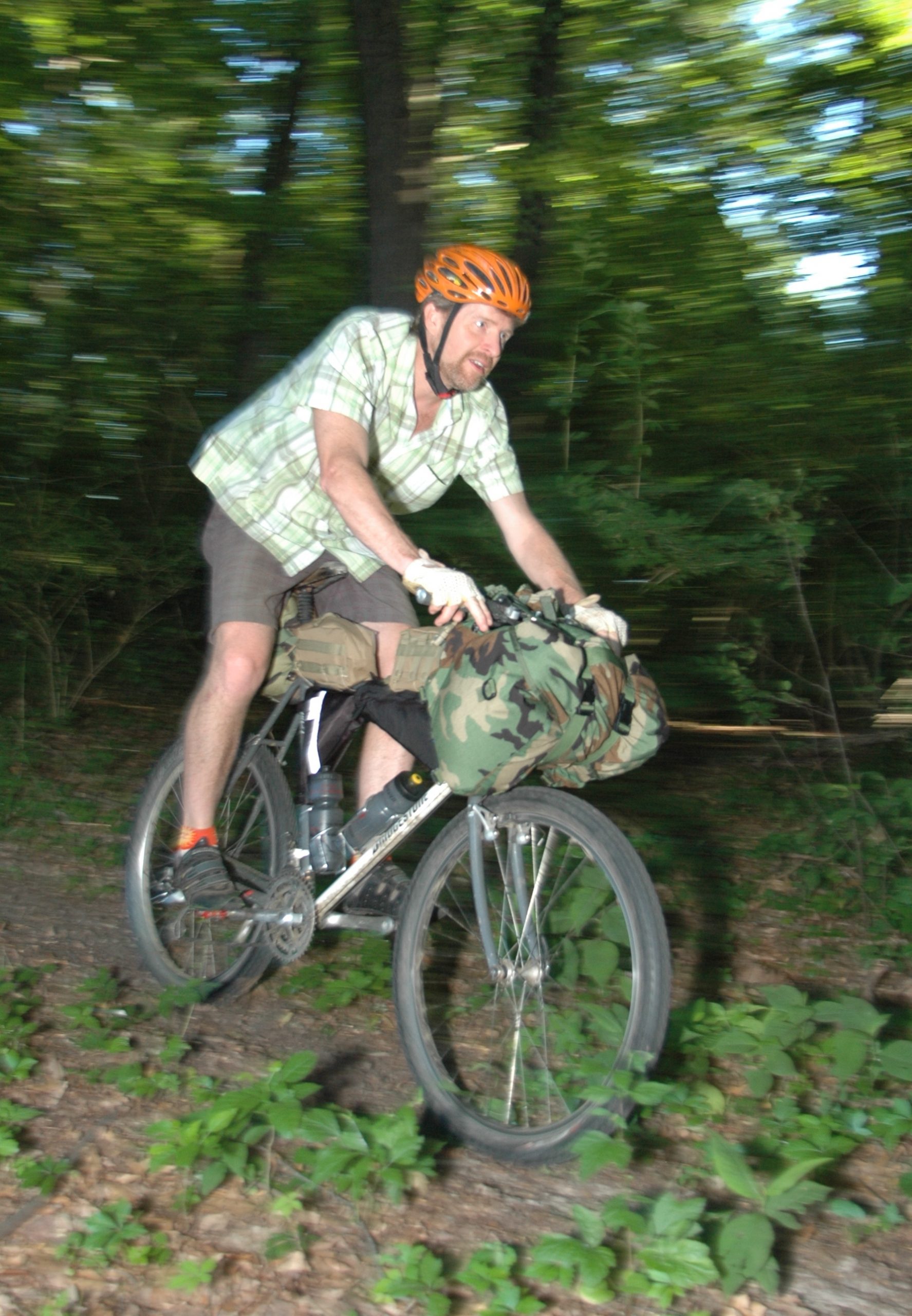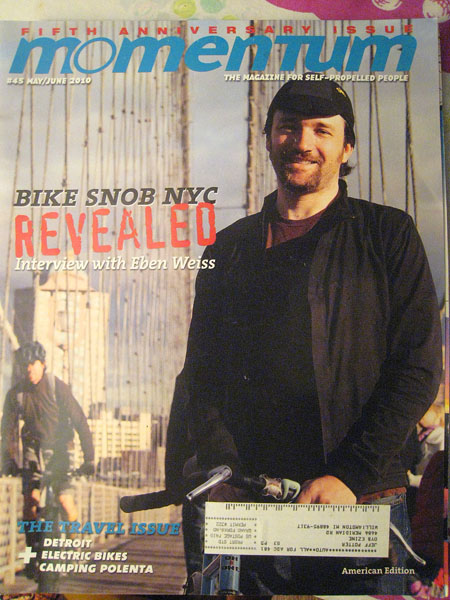More Photos Below!Gallery
So didja know that a dozen different new and old-style military bags make great bike bags?
Here’s a big report on what I’ve discovered along these lines… (If you know a bike magazine that would like to publish it, lemme know! I’ve tried a bunch. No bites. Seems like a cool, original topic to me, though. You know, nothing else like it. Here’s an irony: “Backwoodsman” — not a bike mag — published my article on this stuff happily! They’re more interested in bikepacking innovation than the bike mags!)
First, as you may know, based on all the related goodies I sell here, vintage leather’n’canvas military bags are a great urban bike style — with full-on function.
The new type of military surplus bags offer a special twist: they let you access the brave new world of Bikepacking — bike touring on trails and rough roads, or just lightweight, simpler bike touring — Rackless Touring, in short. This style lightens your load, gives better handling, is cheaper, and lets mtbikes get into the outback singletrack like never before. It also combines with the new ultralight movement, shedding a LOT of weight and complexity. 15 lbs is totally sufficient for a few days. 20 lbs is the new 3-season week+ load.
…AND IT’S ALL AVAILABLE AT THE OYB STORE! I list all the items needed for thrifty bikepacking at my OYB eBay Store. I’ll put them up here at the website soon, too.
Racklessness, as you may know from other reports here at OYB, has also opened up a new scene of self-supported ultra-bike-marathoning, with events like the Tour Divide. These racers were the original developers of this rackless touring mode and spurred two sweet luggage makers: Carousel and Revelate, who supply most of the racers. Military surplus can be used to imitate their wares for $50-100 for a whole rig. (I’m now carrying these bags for sale here at OYB, too!)
So, check it out: there are seven angles to this concept: *vintage appeal; *racklessness; *ultralight; *self-supported racing; *a social aspect here in terms of military culture; *a fashion angle due to the unique range of fabric colors and patterns; *and there’s a massive “reduce reuse recycle” angle.
Here we go! : ) (Lotsa pics at the end!)
Beating Swords into Plowshares… Military Surplus as Bike Luggage — for Touring, Everyday, and Everything Between
On the second day of my last weeklong bike tour I mailed home ten pounds of stuff from the 30 pounds I hauled. I’d brought that much because it was chilly at night and I thought I’d want to dress up and step out on the town after my daily riding. I guessed wrong. Road-living proved to be simpler, and my load seemed heavy. So I did some pruning. I had a dandy tour. Then, within an hour of finishing, I attacked my gear pile and identified another 5 pounds to weed out. Fifteen pounds is my new sweet spot. My ideal luggage set-up evolved into just rear panniers and a handlebar bag — trim’n’tidy. With nothing on top of my rear rack, I had a nice flat place for lashing a bag of groceries at the end of each day’s ride. …Bliss.
More than weight, what peeves me is the idea of hauling stuff I don’t use. Now, many approaches work for touring, including the Kitchen Sink. I’m not forever swearing off extras, it’s just that for me these days I have no interest in them and don’t miss them. I dig wearing arm- and leg-warmers as streetwear off the bike in cooler weather or sleeping in all my clothes when a night is cool. My knees also agree that less is more. It’s a bit like a fixie approach to touring: simplicity rules. Even so, I chuckled at myself after that last tour as I swore off stuffsacks and opted for twine over bungies: but it made perfect sense to me!
Little did I know that my touring world would soon be rocked three times…
Firstly, I looked up touring loads on the Internet and discovered Ultralight Backpacking and its kissin’ cousin called “bikepacking.” What fun!
Secondly, I saw that folks were achieving near-weightlessness by skipping the racks and lashing packs to the bike. Rackless — brilliant! Saves a few more pounds. Saves on having to buy racks in the first place. And saves the risk of having racks break or loosen and lose hardware along the trail. The concept works for any bike, since so many sporting models today, both road and mountain, are made without eyelets. Moreover, the load can be positioned centrally, and more firmly attached, for better handling. It was neat to read how racklessness was first developed by enthusiasts of long-distance singletrack mt-biking: racks and pans broke, were heavy, and don’t work with suspension.
Now, racklessness and ultralight aren’t synonymous, but they cross paths. Mostly, when you ditch the racks there’s not much room for carrying stuff, so bikepacking and UL tend to go together. According to the web-chat, rackless UL touring starts getting serious at 12 pounds. Backpackers launch at an even wimpier 10 pounds, but a bike has extra needs. I suggest that a dabbler can readily hit a 15-pound mark without much expense, using stuff they mostly already have. (UL load weights don’t include food or water, but do include racks’n’packs.)
Critics of “weight-weenyism” say riders often neglect shedding their excess from around the waist. They also mention the junk that riders tend to haul around even after fetishizing their bikes. Bikepacking seems more consistent than garden variety weenyism since it truly considers all the stuff.
There are several ways to approach racklessness: You can flex your credit card hard all the way down to a 10-lb rig. You can save weight by doing without (like the famous whisky-drinking mtbike tourer who reports online about how he sleeps in a trash bag full of leaves). Or you can use common or older items that approximate their specialty peers at a fraction of the price. A lot of DIY also enters into this scene. “MYOG”: make your own gear, baby! Plenty of fun for everyone.
Hard on the heels of those breakthroughs, I was sent reeling a third time when I discovered the Tour Divide mt-bike race. As is better known today, riders push 2700 miles down the Continental Divide, self-supported on mt-bikes. Nearly all the survivors, who tend to finish in a mere 15-25 days, go rackless. And most use packs made by Jeff Boatman at Carousel Design Works. More recently, Eric Parsons of Revelate / Epic joined the action.
The custom-tailored luggage these guys make is impressive. Talk about dialed-in. Whatever your need or frame shape, if you get onto the waiting-list far enough in advance of your trip, it’s yours.
At this point my DIY/budget reflex kicked in. Those custom packs looked a lot like the new MOLLE “strap on” military packs that I’d already been experimenting with for use on bikes, but with racks or just for commuting use. Pronounced “Molly,” it means Modular Lightweight Load-carrying Equipment.
My OYB dayjob has me on the look-out for this kind of thing. So my antennas are on alert.
Lo and behold, several surplus items seem to work well with racklessness. The whole range — for daily-use, for touring, for racks or not — is often available down at the PX — but the vintage items can be scarce.
My list of repurposables isn’t meant to be any final word on how dozens of bags from various countries over the past decades can be used on bikes. Let this list get your own adaptive juices flowing! I look for bags of the right sizes with straps and lash-points in the right places. I try to avoid modifying them (much).
(There are several reports online about folks modifying mil-sup rucksacks as panniers. I just haven’t found a sweet one yet. Kludge has its own cool, though. I also consider function: the main upshot is that these mods end up heavy and kinda permanently attached to a rack. The attachments are always darn awkward or pricey. To me, if you have to use a clunky $50 Arkel clip you might as well buy a real pan. And only a very few rucks will even start to work — you need it small/narrow, and then you have to remove the forward pocket to avoid heelstrike. But I’m always hopeful for a neat solution…)
Going the mil-sup route, you can get a 6-bag rig for rackless touring for $50-$100. Sure, it’s not as dialed-in as a much pricier custom kit, but you don’t have to wait, and it has other perks. Surplus gives us its own special flavor of options to choose from in terms of style, sociology and function.
I sell these goodies at my OYB website, new and used. Of course, if you dig you can find them elsewhere — and some options do require a fair bit of modifying.
If you were enlisted in the Armed Forces you might still have some of this gear, as issued. I had an enlightening chat with a veteran friend when we both were wearing the same military parka. I told him where I got mine. He said “Well, this one is mine.” I then realized it was his duty-issue parka. Such items have never been on the market. It’s theirs, in a very personal way.
The context of military surplus seems worth reflecting on. The impulse to use this gear in civilian life seems to appeal to both peaceniks and militarati. Those vectors aren’t always mutually exclusive. (It’s my impression that those who serve want peace as much as anyone.) But I haven’t seen much surplus on display these days. During Vietnam, there was a lot of it on the hippie streets — it was used by enlisted folks after they got home, and it was bought by civilians of varied persuasions: some used it as an anti-war statement, others dug the fashion, some appreciated the thrifty ruggedness.
Because we have no draft there’s more of a social disconnect which, I suspect, translates into a “surplus deficit.” Yet today’s wars are still a huge social force (duh!). Fewer serve, but every neighborhood has folks involved. Using surplus in life beyond the sandbags just seems like a good thing: It used to be used for blowing things up, then it was wasting away in stockpiles, now it’s back in undreamed-of service on bikes! What’s not to like? Reduce, reuse, recycle!
The new breed of military packs and pouches are made of Cordura with tough plastic clips and Velcro attachments. Vintage means canvas, metal and leather. Either way, it’s designed for versatility, to clip onto a variety of belts, vests and packs. Let’s do what we can to find ever more ways of using them on bikes!
Packs that have seen duty will have the marks of “beausage,” the beauty of use. Newer items often have a variety of camo patterns. Brand new variants are also often offered in a variety of muted colors. Something in this fairly wide range just might suit your druthers.
I think camo can be dandy as fashion. It can also be functional: sometimes a rider wants to be seen (as when road-riding), other times, not so much. I haven’t seen any full-camo riders yet, but maybe they’re out there.
For everyday riding, you know what you need for spare-kits, lunch, books, electronica whatever. For bikepacking, the idea is to lash packs in enough places to stash a different array of specific items. Usually each item has its own strategically selected pack or pouch with little leeway for alternatives. Namely, we’re finding on-the-bike hideouts for: sleeping bag, thin-pad, bivy tent and poles, minimal tools/spares, a few apparel items, a bit o’ toiletry and personal goodies, and enough water, food, and snacks to last between refills. That’s about it. You might be able to wedge a thin paperback in somewhere. Maybe not. Of course, you don’t have to use your rackless rig for touring — it can be hard on groceries, though, tending to work best with compressibles.
So, without more ado, here’s a line-up of luggage I’ve sorted out that covers the bases for touring and everyday uses. In addition to current-era, “as is” surplus, I’ve included my own modified vintage bags along with a few non-military standouts.
*MOLLE II Sleep System Carrier, Sustainment Pouch, Waist Pack: These three each function as a saddlebag or handlebar “burrito” to carry sleeping bag, pad and clothes. In size, they’re respectively large, medium and medium. Select from them for your bikepacking core. ($15-$25.)
*MOLLE PRC-126 Radio Pocket: Stem panniers for snacks and easy-access small stuff. (This specific pocket seems best.) ($5-$15.)
*MOLLE General Utility Pouch: gas-tank or “bento-box” top tube bag; or seatpost/top-tube corner bag for more small stuff: tools, spares, air, clothes. ($5-$10.)
*Frame packs: the main frame triangle is the only space on a rackless bike that’s big enough for tent-poles. In my quest to find a thrifty full-size frame pack to repurpose, someone online suggested Jeep bags. Jeep owners call them “saddlebags,” for storage in the space between roll-bars. A couple brands are made in various sizes at $30-40. To use as frame-packs you need to sew on Velcro or buckle straps. The venerable Jandd partial front-of-frame pack also does great duty here. At $35, it’ll hold a set of short tent-poles and then some, but not a whole tent. Several companies make an upper rear corner-of-frame pack, too.
*Hydration: Since a full-triangle frame pack eliminates typical water bottle cages, a bladder pack is commonly used. Once again, military surplus comes to the resuce, with used carriers as cheap as $10. Some riders use fork mounted bottle cages instead of, or in addition to, a pack. A frame-pack can house a bladder, too.
*MOLLE Gas Mask Bag: attaches to front of another handlebar pouch to increase capacity. ($10-$15.)
*MOLLE Recon Buttpack: a main pouch with 4 outer pockets — with the addition of 3 small leather straps, it makes for a great medium-large saddlebag (or small racked pannier) — for everyday use. ($40.)
*German Army Shoulderbag: medium saddlebag — needs a rear rack — for everyday use. ($10-$15.)
*OYB 7-Way Bag: modified from a Swedish gas mask bag to be a medium saddlebag (and 6 other bag types) — a classy everyday bag. ($30-50.)
*OYB Retro Pannier: modified from a Swiss ammo case to be a small pannier — needs a rear rack — a classy everyday bag. ($30-60.)
*Small rucksacks (such as the German Alpine): some folks modify these into panniers, usually after cutting off a heel-bumping forward pocket, and mounting them to a panel of some kind. 15″ wide x 19″ tall seem to be the limits. Various lashings, bungies, and/or hose-clamps are used. Sometimes shoulderstraps are cut off. I have not yet come across an elegant solution in this variant, but hope springs eternal!
This is an open source code project — always in development. For instance, I’m pretty sure the Sustainment Pouch will also mount nicely under an aerobar, maybe in combination with a Waist Pack — but I haven’t tested it yet. The UK and other countries have their own versions of these pouches and attachments — in who knows what shapes. If you find something that works, let us know. Bikepacking.net is a great forum for sharing. Specifically, if you find a pouch that can double as an upper-half frame pack, it would be great to hear from you. It should be in the ballpark of 18″ long by 4″ high by 2″ wide. (If it was low enough one might be able to be strapped on top of the top-tube, if need be.) Of course, bike frames (and parts) vary hugely in dimensions — which is why the custom approach is popular. So our discoveries might often be limited to particular bikes or sizes. Fine!
A caveat: So far, I’ve only used these bags for mellow overnighters and urban riding. I haven’t heard of anyone using them yet for true enduro action. Some of them I attach with small leather straps that I have a local saddlemaker make by the hundred, but I also use zipties and, occasionally, twine. You may discover better fitments. I don’t pretend to have final solutions. (And I’m looking for a bulk source for narrow buckle-cam webbing straps.)
Finding bags to repurpose for bike use gives me a splendidly tasty creative thrill. It’s an epitome of reduce-reuse-recycle for me. And I enjoy the bag-matcher’s rush. A tidy suit of bags in faded camo, say, adorning a bike looks distinctive, works great, costs cheap and says something. The Three R’s ride strong!
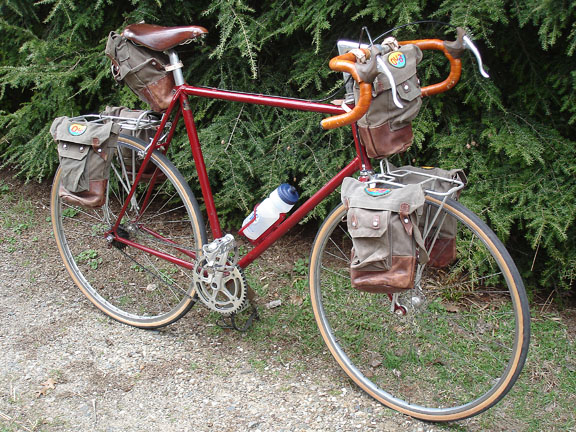
Here’s a plug for my own world-famous Model Perfection OYB modded mil-sup bags. Versatile. But best as saddlebags.
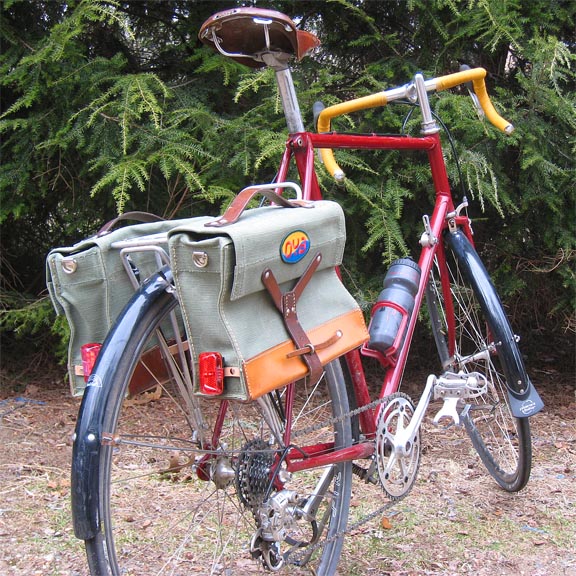
Gotta show my swanky OYB modded mil-sup mini-pans. With a clip-on strap they double as a shoulderbag.
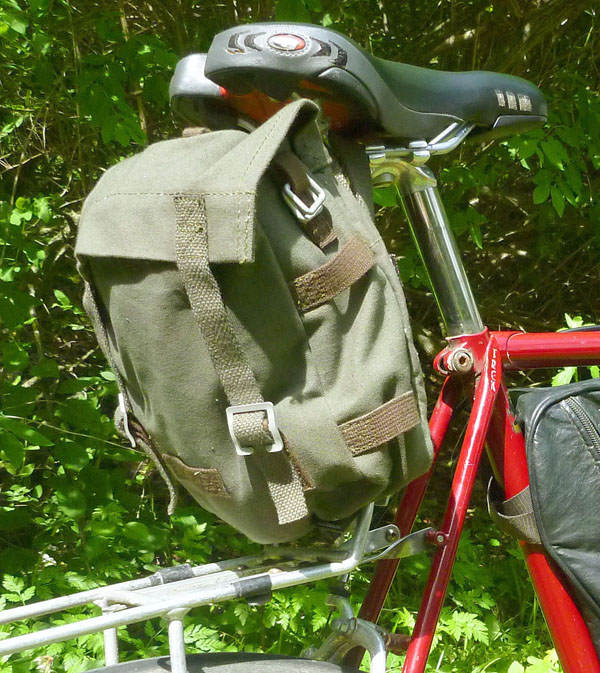
Vintage German Shoulderbag.
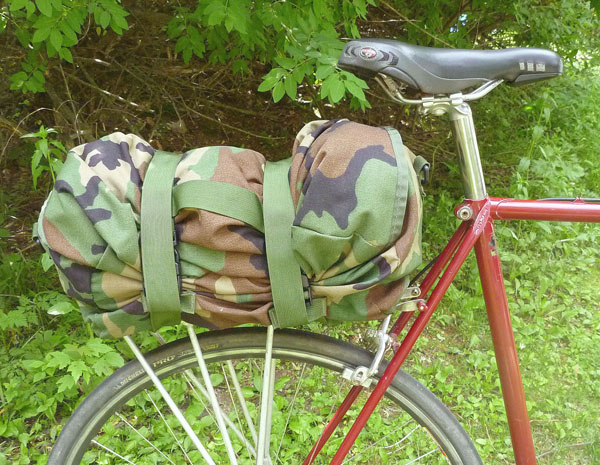
MOLLE Sleeping Bag Carrier. Core item. Works as a rack trunk, seatpost burrito or bar burrito.
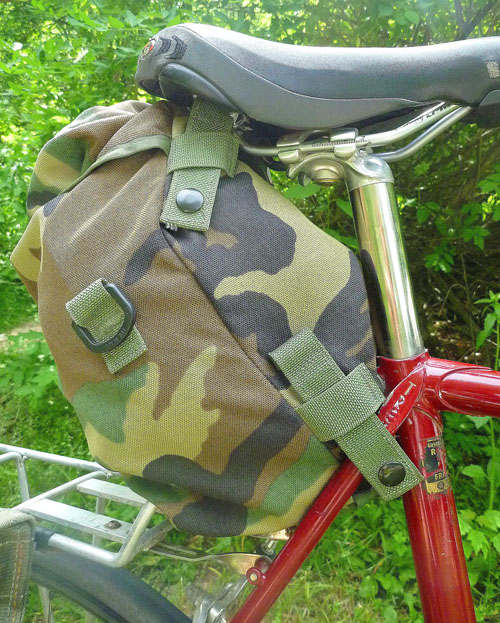
MOLLE Sustainment Pouch. Core item. Also works as Handlebar-bag. Rockin’!
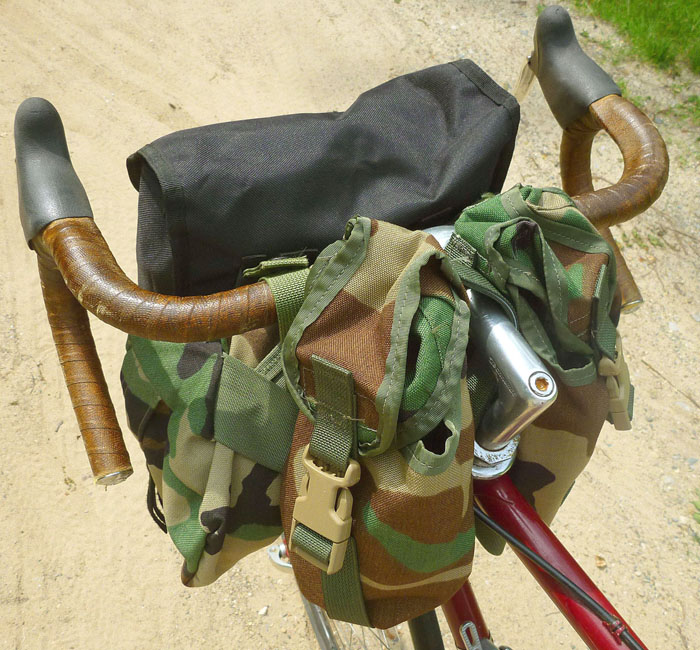
Road cockpit. Stem pans (Radio Bag). Medium bar burrito (Waist Pack) with black extra pouch (Gas Mask Bag) layered on top.
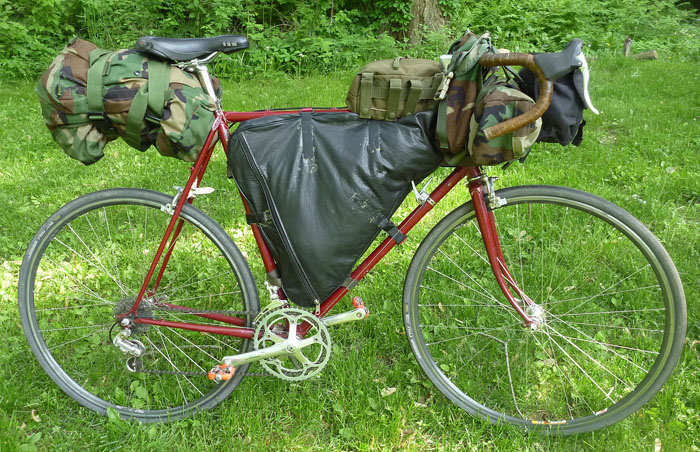
Rockin’ rig for road or roughstuff rides.
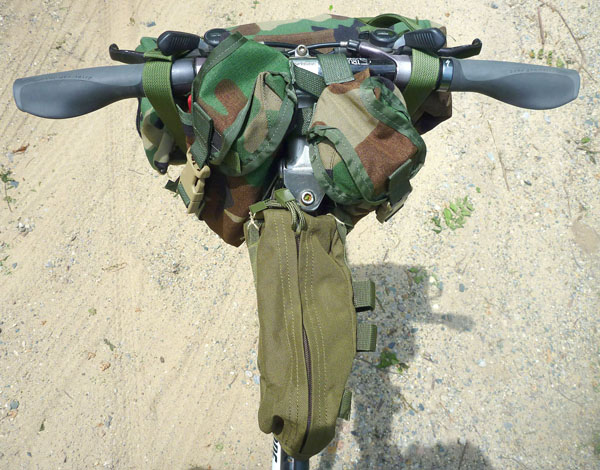
Dirt cockpit.
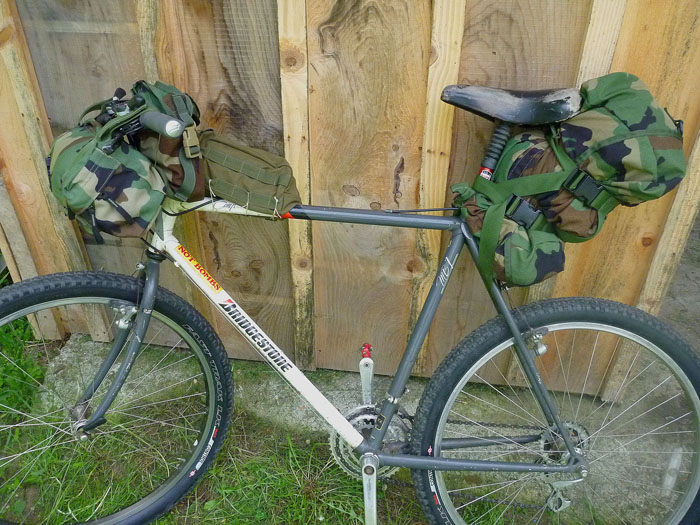
One of several overnightable bag combos. I have everything I need there: bag, pad, tent, clothes, tools, snacks and more. Can work for highpost road bikes, too.
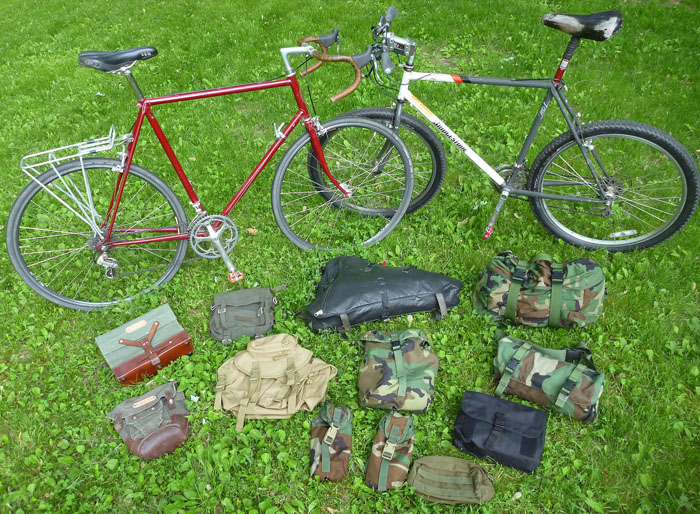
A buncha thrifty, mil-sup and/or modded bags for dirt or road.
Rear view.
Side view.
All I need or want for a week of fun. Handles great. Light. Simple. Cheap. Robust. (The front bag could be lashed tidier.)
